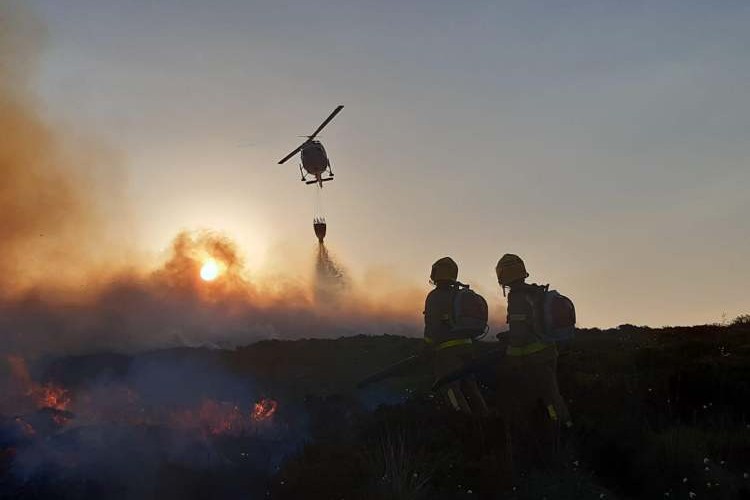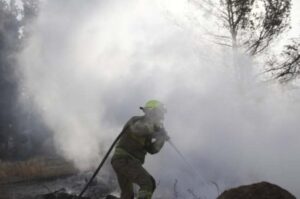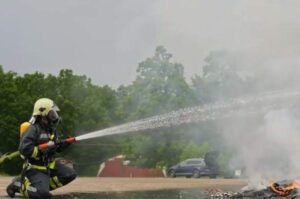
What caused Israel wildfires: It is rare for a natural disaster to so brutally expose the fault lines of a nation’s governance, but the raging wildfires west of Jerusalem have done precisely that. Just as Israel prepared to celebrate its Independence Day, flames tore through more than 5,000 acres of forest and farmland, crippled its main highway, and forced emergency evacuations around its capital. The fire may have been sparked by wind and heat, but its true accelerants lie in years of ecological mismanagement, political theatrics, and a climate regime that governments still treat as peripheral.
For those of us in the Global South, this is not a distant catastrophe. It is a mirror. Much like the infernos that now rage with increasing frequency across the Mediterranean, the Indian subcontinent, and parts of Africa, the Israeli wildfire is a parable of how flawed land-use choices, short-sighted governance, and denial of climate realities turn natural landscapes into engineered disaster zones.
READ I Geospatial mission to back urban planning, climate action
A climate trap of our own making
The Israel Meteorological Service had already sounded the alarm: temperatures climbed to 39°C, humidity plunged below 10%, and dry winds gusted at up to 80 km/h. These were not freak conditions—they represent a troubling new normal. Average July highs in Jerusalem have risen 2.8°C since the mid-20th century, while the country’s mean annual temperature has increased by 1.8°C in the past decade alone. The eastern Mediterranean is now warming 20% faster than the global average.

This year, Israel also recorded its driest winter on record, a fact confirmed by the national water authority. With rainfall vanishing and vegetation desiccating, the region has become primed for combustion. NASA’s fire-tracking maps show blazes erupting not only in Israel but across Turkey, Lebanon, Syria, and beyond—proof that the crisis is regional and systemic.
As Israel’s President Isaac Herzog rightly noted, the wildfire is not just a natural disaster—it is a climate warning. “This fire is part of the climate crisis, which must not be ignored,” he declared, calling for urgent legislative and policy reform. His words stood in contrast to the prevailing political reflex: to seek culprits instead of solutions.
Human hand in Israel wildfires?
Almost immediately, political leaders rushed to assign blame. Prime minister Benjamin Netanyahu and national security minister Itamar Ben-Gvir claimed Israel wildfires might be acts of arson, with hints of terrorist intent. Netanyahu even implied Palestinian incitement, stating, “They talk about burning the land… We protect the land.” He claimed 18 people had been arrested for arson—including one caught in the act—only for police to later clarify that just three arrests were made, none connected to the main blaze.

The contradiction was not just factual, but symbolic. In an era where public trust hinges on clarity and credibility, this choreography of accusation before investigation erodes governance itself. Netanyahu later edited the video of his speech to remove the erroneous arrest count—an implicit admission of overreach.
Social media amplified the chaos. Netanyahu’s son suggested, without evidence, that left-wing critics might be behind the fires. Ben-Gvir responded by launching a counter-incitement task force to surveil digital spaces for talk of arson. The state’s response thus migrated from fire suppression to narrative control.
This is not a uniquely Israeli problem. Around the world, governments facing disasters are tempted to weaponise fear, vilify rivals, and centre politics over prevention. But this response deflects from the more urgent and universal question: why do nations burn again and again as if history were wiped clean by ash?
Designing landscapes to fail
In trying to “make the desert bloom,” Israel’s early planners planted swathes of flammable Aleppo pines—resinous, fast-growing, and dangerously combustible. Today, these monoculture plantations act as vertical flame accelerants, with crown fires capable of leaping kilometres. Experts have long advocated for native oak or carob woodlands and traditional terrace agriculture to enhance moisture retention and fire resilience. Instead, urban sprawl has crept into vulnerable zones, leaving firefighters to defend homes built at the wildland-urban interface.
This, too, is a globally familiar pattern. From California to Greece, aggressive development and ecological simplification have created a combustible future. Biodiversity has been sacrificed on the altar of convenience, and the results are now searingly visible.
Budget cuts, forgotten lessons
The Israeli Climate Forum warned in March that the fire season would be severe. The government responded not with urgency, but with austerity—slashing 217 million shekels from the Fire and Rescue Authority. Helicopter leases were cancelled, recruitment frozen. The country now deploys just one firefighter for every 4,500 citizens—far below international norms.
The pattern is hauntingly familiar. Lessons from Israel’s catastrophic 2010 Carmel fire—on firebreak maintenance, early-warning systems, and community readiness—have languished in bureaucratic oblivion. And once again, as the smoke billowed, commanders scrambled for aircraft from Italy, Croatia, and Cyprus. A country that leads in drone warfare and cybersecurity has failed to invest in basic resilience.
From ritual to reckoning
The Israel wildfires did more than scorch earth; it disrupted the cultural core of Israel’s civic life. Independence Day festivities—the torch-lighting ceremony, fireworks, even park barbecues—were cancelled. The symbolism could not have been starker: on a day meant to celebrate sovereignty, nature answered with fire and silence.
Yet amid despair, there were flickers of resolve. “Every burnt tree hurts,” the Jewish National Fund posted. “Every damaged acre is a reason to keep fighting.” That fight, however, cannot be waged by slogans alone. It demands resources, foresight, and an honest reckoning with a changing climate.
The Israel wildfires are no seasonal anomalies. It is the harbinger of a new age of climate insecurity. The science is clear; the warnings are old. What remains in question is the political will. No nation is immune to fire. But every nation has a choice—to prepare for it, or to pretend it will be someone else’s tragedy.
